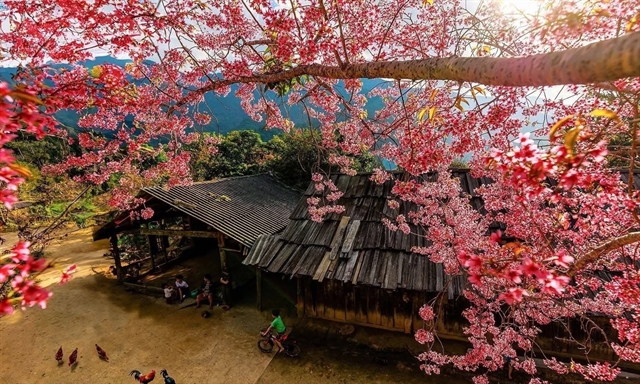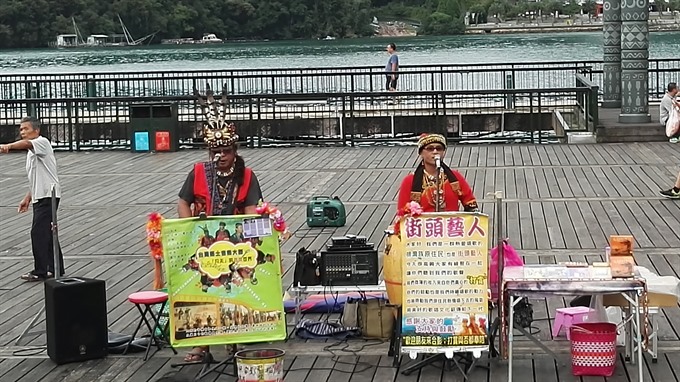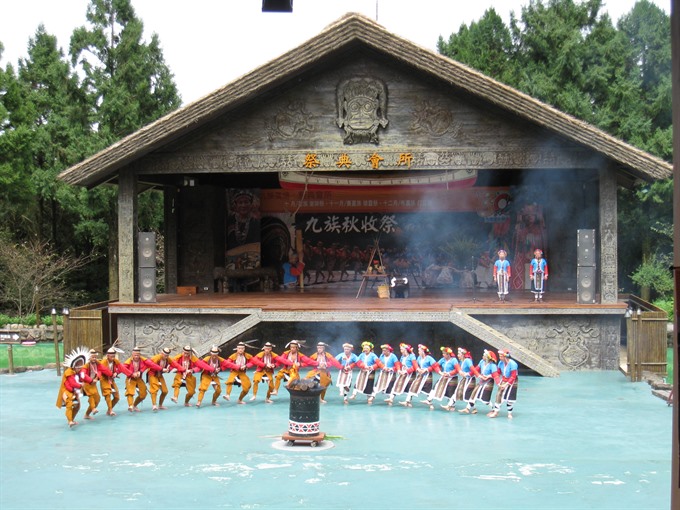 Travel
Travel

I begin a one-day tour in Tai Chung, in central Taiwan, on a beautiful day in autumn. The weather is so cool that it makes me feel happy to mix with the green atmosphere and daily life of the local residents.
 |
| High places: A corner of Chung Tai Chan Monastery, a majestic spiritual landmark in Tai Chung. |
by Thu Giang
HÀ NỘI — I begin a one-day tour in Tai Chung, in central Taiwan, on a beautiful day in autumn. The weather is so cool that it makes me feel happy to mix with the green atmosphere and daily life of the local residents.
It’s 8am when my friends and I leave our hotel in the centre of Tai Chung City to ride in a passenger car, which takes us to the Formosan Aboriginal Culture Village - about 60 kilometres to the south of the city.
Our car drives on the highway, which winds through mountains and hills. The mountain range is not too high, so it easily allows for views of a picturesque mountain with white clouds drifting and bobbing around the top, while the bright morning sunlight travels down through clouds, along with sparkling paddy fields and highlighting the roof of several houses built separately on the mountains’ slopes.
On the way to the village, Chiu Yi-Chuan, a local tour guide, tells us that since first opening in July 1986, Formosan Village had become popular for its introducing Taiwanese aboriginal culture and for its lush forest and beautiful European Garden.
Chiu, who speaks Vietnamese fluently, says the village has added an amusement park and other attractions since 1992. The large numbers of attractions ensured the position of the village as a highly competitive and leading edge theme park in Taiwan.
The green village gathers together 14 ethnic minority groups. Each group has its own characteristics that are displayed in their traditional houses, clothing, lifestyles, musical instruments, hunting tools and jewelry in the museum.
 |
| Full plate: An appetiser at a restaurant in Tai Chung. |
I am very lucky to have visited the village during a performance by local dancers. In the theatre, located in the middle of a small lake, Paiwan ethnic minority dancers are in traditional clothing and dance around a stack of firewood burning during their thanksgiving festival.
It is the dance that displays the power of humans who are willing to deal with difficulties to obtain a peaceful life.
The 22 year-old tour guide, intern Esther Chen, who speaks English fluently, says this is the traditional festival of the Paiwan people. The festival is organised to ask their ancestors to return home and enjoy the party. They give thanks to the ancestors and wish for a good crop, love among people and a peaceful life.
Many dancing and singing performances take place in the theatre. The most interesting one may be the interaction between artists and audiences when the performers throw souvenir gifts towards them.
After going around the village on a small path with many trees planted alongside, we enter a restaurant for lunch in a corner of the village, which offers a really impressive meal. I don’t know the names of traditional dishes, but I do believe that they have been made with the heart and skillful hands of the chef. The dishes are made of seafood, pork, chicken, beef and salted eggs, and all are presented with a beautiful and colourful décor, highlighted with local special vegetables, spices and flowers. It’s nice that I don’t want to destroy its shape, but I am hungry and eager to enjoy the taste.
Sun Moon Lake
After a break with my friends at lunch, we get in the car to continue to Sun Moon Lake, which is the largest fresh water lake in Taiwan and located at the heart of Tai Chung.
Watching from an overview of the lake while in a cable car at the top of the mountain, about 1,000m high from the water surface, I see it is a natural and majestic landscape of lake and mountains, with Lalu Island in the middle of the lake.
With an explanation from tour guide Chiu Yi-Chuan, I can imagine the shapes of the sun in the north and the crescent moon in the south, which is why its name is Sun Moon Lake.
We enter the boat station to begin our trip around the lake.
The station is busy, with several street music bands performing folk songs. I don’t understand the songs’ contents, but their lively voices and sounds from instruments make me want to dance.
It’s an amazing feeling, sitting on the boat to enjoy snacks and chat with friends, surrounded by a fresh and cool breath of air.
In term of the multiple ethnic groups and cultures, the indigenous groups include Ita Thao, Taypina Wa and Bunun Tannan.
“The lake is the heart of this area. Local residents always gather here to enjoy fresh air, cycling around the lake, walking and exercising in the morning and evening. It’s an indispensable part of the local life,” said Chiu.
Tradition has it that Thao ancestors came across Sun Moon Lake when hunting a white deer. The Thao is one of the indigenous ethnic groups in Taiwan and the earliest inhabitants in the Sun Moon Lake area.
Alexandre Brilleaud, a French visitor who is working in the finance sector in Taiwan, says this is the first time his family from France has visited him in Taiwan.
He noted that Sun Moon Lake is his first choice for sightseeing.
“I am really impressed with the colour of the lake’s water. It’s unique for its colour of between blue and green. The light shining from the sun makes a great picture,” said Brilleaud.
Chung Tai Chan Monastery
The Chung Tai Chan Monastery is a majestic spiritual landmark in Tai Chung.
It’s an imposing pagoda that makes me feel so small in the world of Buddhas, while the tour guide, who is also a nun from the pagoda, shows us the architecture of the monastery, which expresses a harmony of the arts, culture and science.
Chung Tai resembles a cultivator surrounded by mountains, sitting in meditation, majestic and serene. The entire structure reflects the Dharma, embodying the unification of sudden enlightenment and gradual cultivation.
Going up the pilgrimage stairway to the centre of the monastery from the Buddha halls, I perceive the wonder and profundity of the Buddha Dharma. Towering high above us, the four heavenly kings guard the four directions. Their dignified presence is a reminder to all people: Do no evil and perform only good.
The statue of Shakyamuni Buddha sits at the centre of the Great Majestic Hall on the second floor. Small Buddhas on the nimbus indicate the various manifestations of the Buddha in his vow to guide sentient beings and to continue returning to this world of samsara.
The Great Majestic Hall on the fifth floor illustrates the Avatamsaka Lotus Realm, where many Buddhas preside. The Rocana Buddha is wearing the thousand-Buddha robe and sits on the thousand-lotus platform.
The ceiling is an admirable artwork, hand-painted by Taiwanese artists, depicting the splendor and perfection of the realm.
Entering the hall of ten thousand Buddhas is like placing oneself in the realm of the Buddhas.
“The small bronze Buddhas were made by Vietnamese artists,” says the nun, adding that the halos of the surrounding Buddhas are illuminated using energy saving optic fibers.
It’s really interesting to see an overview of the pagoda through massive glass curtains. It is visible high in the air, showing sentient beings the entrance to Buddha’s world. — VNS
 |
| Music for you: A street band performs folk songs at a wharf on the Sun Moon Lake. |
 |
| Between green and blue: The colour of its water is said to be a unique aspect of the Sun Moon Lake. — Photo Thu Giang |
 |
| Thankful moves: Paiwan ethnic minority dancers in traditional attire dance around a stack of burning firewood during their thanksgiving festival. |




